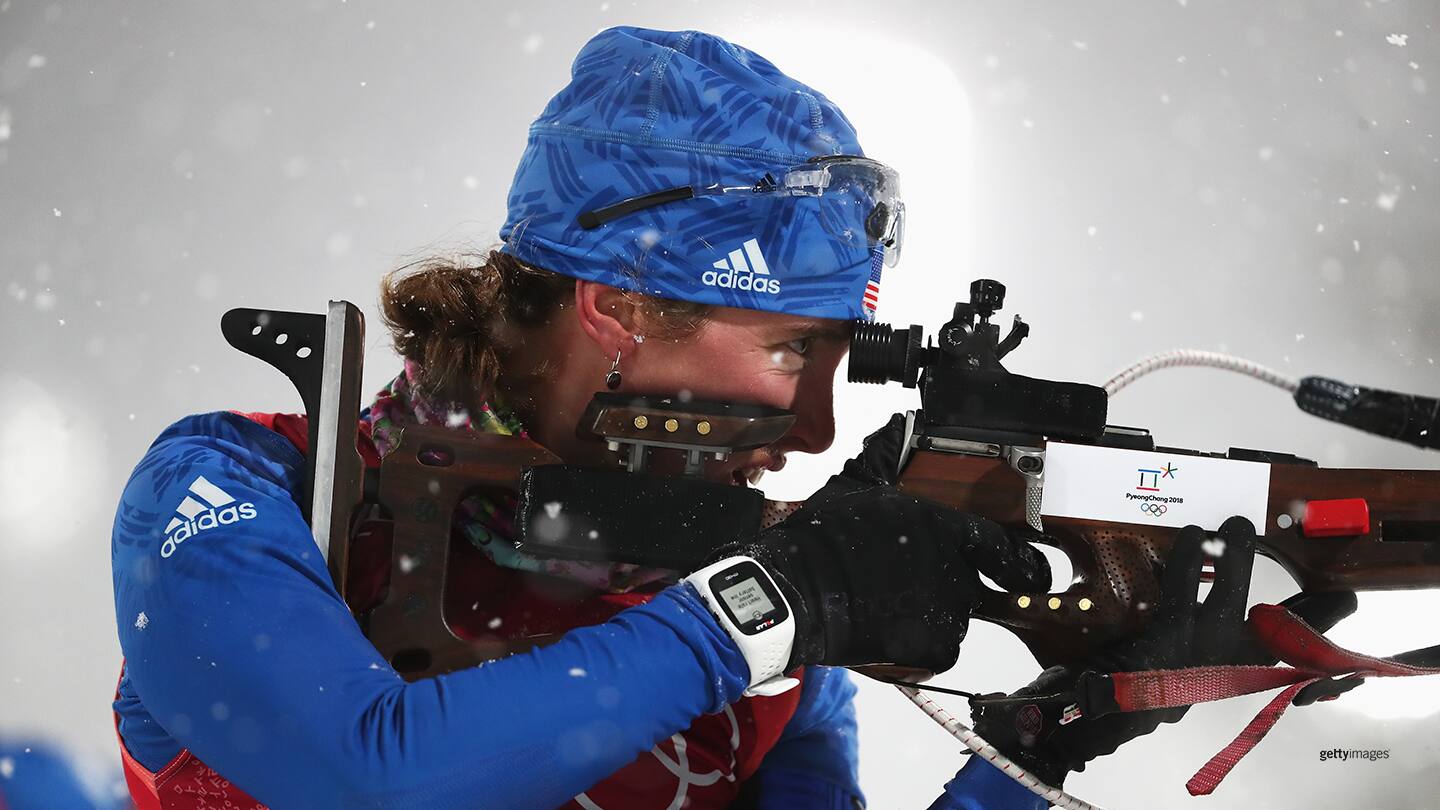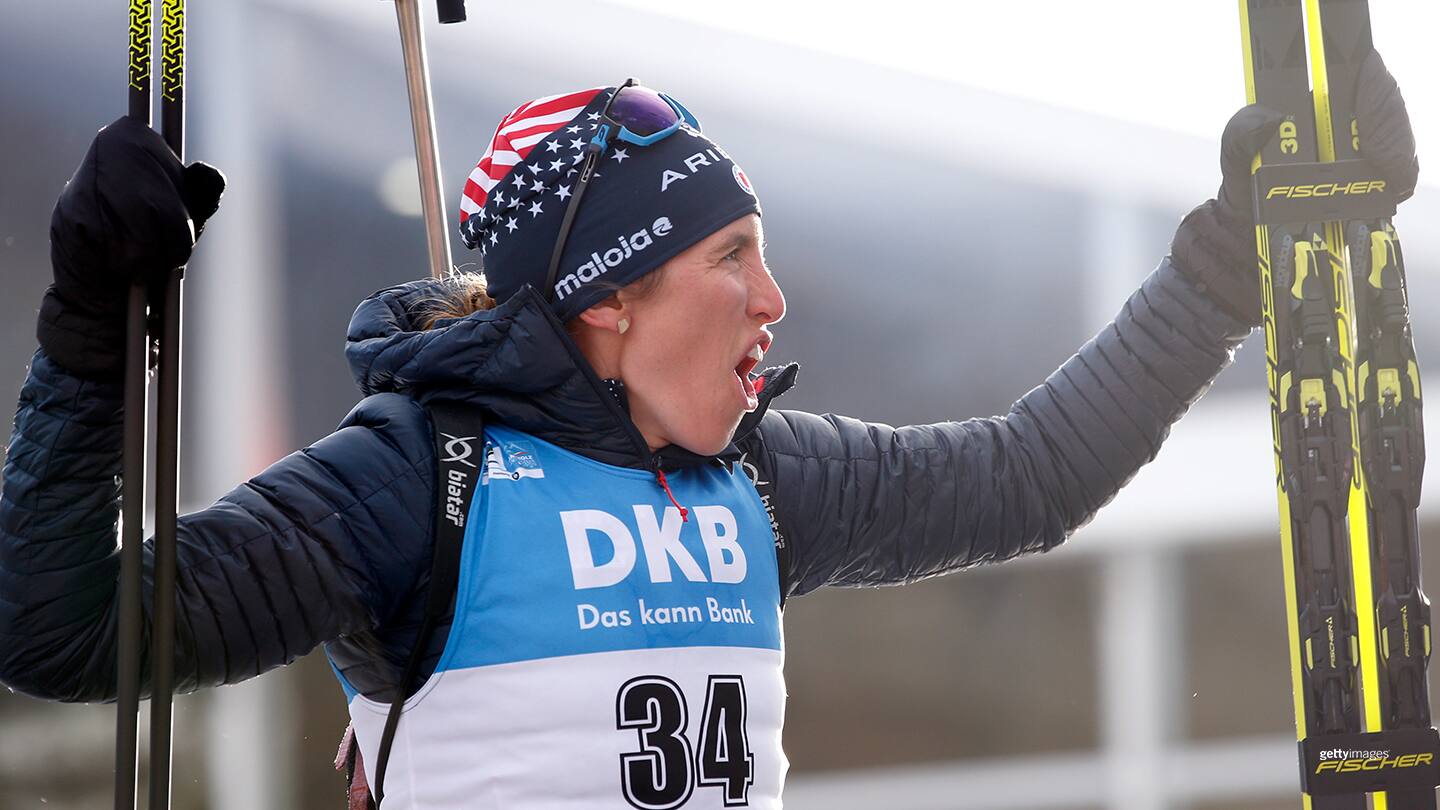
Older Athlete Community Inspires Olympian Susan Dunklee In Her Final Biathlon Season
by Peggy Shinn

Susan Dunklee celebrates winning the 2nd place at the IBU World Championships Biathlon Antholz-Anterselva on Feb. 14, 2020 in Antholz-Anterselva, Italy.
When Susan Dunklee took up biathlon after graduating from Dartmouth College in 2008, she thought she would compete for a year or two.
But she got hooked. Now, 13 years later, the 35-year-old Vermonter has two world championship medals, several world cup podiums, and two Olympic Games on her resume — with hopefully more to come this winter.
The 2021-2022 season, which opens at the end of November, will be her last competing as a professional biathlete for the Craftsbury Green Racing Project and Team USA. From her home in Craftsbury, Vermont, Dunklee talked about why she chose to stay in biathlon for the last few years and how she set herself up for the next chapter in life.
Her insights and actions are instructional for any athlete nearing the end of her/his career.
Legacy
Since 2018, Dunklee has been on the fence about retiring from biathlon. As that Olympic year came to a close, she looked around and realized that she wanted to continue helping the U.S. women’s biathlon team.
At that point, Clare Egan and Joanne Reid, a former NCAA cross-country ski champion, had started climbing up world cup results, and a crew of younger biathletes, including Dunklee’s Craftsbury teammate Hallie Grossman, were competing well in IBU Cups (a step below the world cup).
“I didn’t like the idea of leaving at that point because I wanted to leave more of a legacy than just the results I have,” said Dunklee. “I wanted to make sure we had a self-sustaining strong group of women behind me.”
The following season, Egan made her first world cup podium and Reid scored a couple of top 15s, including tenth in the mass start at the 2019 world championships. The U.S. women, Dunklee realized, could be competitive in the relay, where four women each race 6 kilometers and go through the shooting range twice.
During the 2019-2020 season, the U.S. women scored six top ten finishes in the relay, and Dunklee had another breakout performance at world championships, winning the silver medal in the sprint — to go with her silver medal from the 2017 world championships (from the mass start race).
The Covid-19 pandemic sent everyone home before that season ended, and as Dunklee contemplated the 2020-2021 season, she kept training that spring.
“Training gave me purpose and a routine and structure at a time when I really needed it,” she said. “It made a lot of sense for me, coming off of a really successful season with the silver medal, to keep pushing for another year.”

Susan Dunklee shoots during the women's 4x6 kilometer relay on of the Olympic Winter Games PyeongChang 2018 on Feb. 22, 2018 in Pyeongchang-gun, South Korea.
But after an off-season training at home without her coach, Dunklee did not feel great in races last winter. To keep the sport fun, especially with the Covid restrictions, she took a kite on tour with her — to bring some color to bleak gray winter days in Europe.
And then she and Egan created more fun.
Egan is an athlete representative on the IBU executive board. In one meeting, the board discussed creating a blue bib for the best U25 (biathletes under age 25). The overall men’s and women’s world cup leaders wear the yellow bib, and younger athletes who are working to develop in the sport could aspire to win the blue bib (similar to the Tour de France’s white jersey for the best young rider). Egan — who turns 34 on November 19 — joked that the IBU should create a gray bib for older biathletes.
After the meeting, Egan mentioned the gray bib to Dunklee, who loved the idea. They then talked to their peers on the circuit. Anais Bescond, a French biathlete who’s been in the sport since 2007, thought it was a good idea, but the color gray wouldn’t do. Gray, she said, is too sad.
Bescond suggested silver — something more distinguished.
The bib, they decided, should be knit —“old lady style.” So over the Holidays, Dunklee knit two silver bibs (one for the men, one for the women). The number on the bib: 33+, to signify the age class.
How did they settle on 33?
They looked at how many biathletes on the IBU World Cup tour are under age 25. For parity, they selected a cut-off age with a similar number of older athletes (about ten per gender, give or take).
A young biathlon fan in France started a silver bib Instagram account to keep track of the leaders. It saved Egan and Dunklee from doing the math themselves.
At the end-of-season awards ceremony, Egan made sure the silver bib presentation was on the program, and Bescond and Jakov Fak from Slovenia were presented with the knit bibs and silver goblets.
“The silver bib is an honor,” Bescond told reporters after the accepting the bib. “Even if it started as a joke between us at the beginning, I am glad to have won it. I know it is probably the only overall I will get in my career!”
“Surprise, surprise, 33+ champ,” Fak posted on Facebook. “I am like wine; the older the better … .”

Susan Dunklee celebrates after taking 2nd place during the IBU Biathlon World Championships on Feb. 14, 2020 in Antholz Anterselva, Italy.
As winter turned to spring 2021, Dunklee again was on the fence. Was it time to retire? At age 35, her body was not recovering as quickly as it used to from long, hard workouts. And her motivation had slipped.
“Early in my career, I was willing to give 100 percent every single day, and it didn’t matter how hard,” she said. “I would outwork anybody out there.”
But in the last four years, that 100 percent had slipped to 99 percent.
“It’s the hunger to want to go out in the rain and do whatever it takes to get yourself up there,” she said.
She contacted other silver bib contenders — even outside of biathlon, including cross-country skier Kikkan Randall who won an Olympic gold medal in 2018 at age 35. Dunklee asked these women how they had adapted their training as they aged.
Across the board, the older endurance athletes suggested that Dunklee lower her training volume. In other words, drop an afternoon distance session after a hard morning workout and skip overly long cool-down sessions after intensity workouts.
“When you’re younger, you’re pushing the volume to be able to build your capacity and keep improving your VO2 max,” explained Dunklee. “At this point, it’s more about the quality of the sessions and doing really good work with intensity, then recovering from it.”
Last summer, she backed off her training volume “a few percentage points” but made sure she focused on doing her intense sessions correctly. Her mantra was “do what matters.”
“If I were competing with my 25-year-old self, my 25-year-old self definitely would have more motivation, it’s just something I can’t really change right now,” she said. “But what I have over my 25-year-old self is that I am a lot smarter about how I approach things.”
Interacting with other older athletes motivated Dunklee to compete for one more year. She also wanted to find the next challenge in life before she moved on — to have a job lined up by the fall so she could enjoy her final year on the biathlon circuit.
“If you’ve been in the sport for a long time, and your whole identity has been wrapped up in sport, having the resources and support to be able to think about who you are outside of that and what’s going to come next is extremely important,” she said.
In 2019, Dunklee had attended the Next Step Program at Dartmouth’s Tuck School of Business — which she heard about through another Craftsbury friend. The program helped shift her thought process toward the next chapter of her life.
Come spring 2022, Dunklee will segue from elite athlete to the director of the Craftsbury Outdoor Center’s running program. Part of her job responsibilities will include coaching.
Between now and then, Dunklee is working at her job when she can. But she is focused on one more season of IBU World Cups and hopefully one more trip to the Olympic Games.
As for winning the silver bib, both Dunklee and Egan hope claim the honor.
“We are in the hunt this year,” she said. “We want to catch Anais Bescond. Hopefully, whoever has a strong Games can have a strong silver bib performance too.”